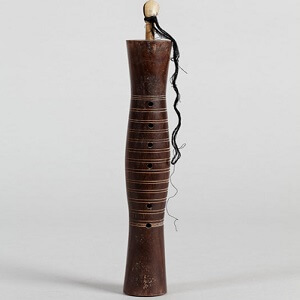Sralai
 The sralai is a Cambodian wind instrument that uses a quadruple reed to produce sound. The instrument is used in the pinpeat orchestra, where it is the only wind instrument. The set of quadruple reeds are made of palm leaf. The bore of the instrument is not evenly bored, but "slightly conical." Its cousin, the Western oboe, has a double reed and a conical bore.
The sralai is a Cambodian wind instrument that uses a quadruple reed to produce sound. The instrument is used in the pinpeat orchestra, where it is the only wind instrument. The set of quadruple reeds are made of palm leaf. The bore of the instrument is not evenly bored, but "slightly conical." Its cousin, the Western oboe, has a double reed and a conical bore.
It consists of a large wooden body, biconical and with a central bulge. It is pierced with six play holes. The four upper holes are equidistant while the two lower holes are slightly further apart, forcing the player to spread the two lower fingers further apart than the four upper fingers. There is a decoration around the holes called kantuet. In addition to its quadruple reed, what characterizes it is its very slightly conical bore, whereas conicity is a characteristic of oboes throughout the world. The body is made of black or red wood: kranhung, neang nuen. The instrument has no pirouette, this piece of horn or metal inserted between the base of the reed and the upper body of the instrument because the large diameter of this sralai already plays this role.
The playing of sralai, whatever its nature, is based on the technique of continuous breathing, thus meeting the criteria, dear to Khmer music, of refraining from silence, however brief it may be. This constraint, combined with the length of certain ceremonies, makes the practice of the oboe a physical performance. In the past, the oboe was the leader of the pin peat orchestra, a role that is now played by the xylophone roneat ek.